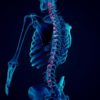By Guest Blogger, Dr. Perry Nickelston
Some musculoskeleteal conditions are more difficult to resolve than others. They become constant chronic reminders of just how vulnerable we are to injury. Traditional therapeutic modalities and programs often hit a wall in helping chronic pain problems, forcing people to rely on pain medication or unnecessarily living with symptoms. Class IV laser therapy may be a simple, effective, and fast acting treatment option for stubborn conditions.
Whenever there is pain, there is biological chemical damage to cells of the body. These chemicals cause inflammation, swelling, pain, and tissue damage. Acceleration of tissue repair is the long-term goal in resolving pain. So how can Lightforce Therapy Lasers help? Laser therapy stimulates cellular regeneration and repair on the cellular level via a process known as photobiomodulation. Light penetrates deep into the body to stimulate repair to the most often damaged tissue structure (myofascial connective tissue).
What are some conditions that resolve with Class IV laser therapy when nothing else works?
1. Tendonitis– An overuse syndrome where micro-trauma damages tissue via constant wear and tear on areas with high impact, stress, and external load. Common locations are the elbow, ankle, shoulder, and knee. Laser therapy to the injured area and surrounding fascial structures lessens fascial adhesions and increases microcirculation. Often only a single session is needed to feel a significant improvement in symptoms.
2. Plantar Fasciitis– A stubborn condition that is tough to get rid of. Patients can suffer years without any change in long-term relief. Laser therapy on the plantar surface of the feet alleviates tension up the entire back line of fascial tissue. Reduction of tension along the back helps improve the foot and heel strike improving impact patterns of the foot and pain.
3. Arthritis Pain– Swelling and inflammation from joint compression can be debilitating. Often the only relief patients get is from strong prescription pain and/or anti-inflammatory medication. Long term use of which can cause damage and side effects to the liver and digestive system. Laser therapy can significantly reduce pain and inflammation associated with arthritis, thus allowing dosages of pain medication to be decreased or often eliminated.
4. TMJ Syndrome– Severe jaw pain may be caused by trigger points in the muscles of mastication and or discal irritation in the condyle. Laser is a noninvasive way to reach the deep muscles and joint space of the jaw, reducing irritation and pain. Application of laser to the jaw, cervical spine and head relaxes muscle tension and tone which are causative factors in joint misalignment.
5. Carpal Tunnel Syndrome– Clinical case study for laser therapy was performed on carpal tunnel syndrome patients over a decade ago in the US. Laser therapy applied to the wrist, cervical spine and arm may alleviate nerve irritation and friction from fascial structures. Numbness, tingling, and paresthesia symptoms are reduced with laser light stimulation. Pressure around the nerve bundle in the wrist is lessened with the increase in microcirculation. Laser therapy is an effective alternative to invasive surgical intervention.
Often a series of 6-10 Class IV laser therapy sessions are required for optimal results.
